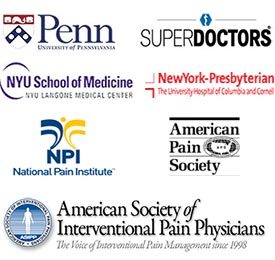Patellar Tendinitis (Jumper’s Knee) Specialist Doctors NYC
At Manhattan Pain and Sports Associates you’ll get the knee pain management and care you need to reduce or eliminate your patellar tendinitis (Jumper’s Knee). Because when you’re in pain — whether it’s from an accident, sporting injury, age or ailment — you want pain relief. Appropriate and targeted treatment starts with a proper patellar tendinitis (Jumper’s Knee) diagnosis from our specialists.
Also called patellar tendinitis, jumper’s knee can affect anyone, but it’s most common among athletes who play a sport that involves a lot of jumping, such as basketball. Jumper’s knee causes knee pain, stiffness and swelling, but it’s generally considered a mild condition. Ask any pain management doctor in NYC about jumper’s knee, and you’ll hear that it’s easily treated.
The patellar tendon connects to muscles that hold your kneecap, or patella, in place above your shin bone, or tibia. The patellar tendon and muscles allow you to extend your knee to straighten your leg. Jumper’s knee is usually the result of an injury to the tendon or from repeated jumping. In a sense, jumper’s knee is similar to carpal tunnel syndrome in that both are caused by repetitive motion.
The Symptoms of Jumper’s Knee
While you can recover from jumper’s knee, it can be painful, since the pain radiates from beneath your kneecap. Initially, you may feel it only after a game or a workout session. But if you leave it untreated, it gradually worsens, intensifying the longer you’re on it. Sooner or later, the pain will cause you to stop your workout or leave your game.
You may notice some swelling and a reddish tint around your knee. If you still don’t treat it, you’ll begin feeling the knee pain in your everyday activities. At this stage, you can trigger the pain with any movement that puts pressure on your bent knee, such as walking up a flight of steps. If you persist in ignoring the pain, you’ll only make your problems worse, as you can tear the tendon, which then may require surgery to repair.
Don’t Make Jumper’s Knee Worse
You can try putting ice on your knee for temporary relief, but this is one illness you want to treat early. If you play basketball or volleyball and you start to feel pain from your kneecap, seek a top pain management specialist, like Manhattan Pain and Sports Associates. Their physicians can diagnose jumper’s knee and give you effective treatment.
Your doctor will ask you how long ago the pain started and what your current symptoms are. You may need tests — such as an X-ray, MRI or ultrasound — to confirm the diagnosis. Often, the doctor orders the tests to rule out other conditions and to narrow in on the actual problem. Once you know conclusively that you have jumper’s knee, your treatment can begin.
Treatment Options for Patellar Tendinitis
In Manhattan, pain management physicians start with non-invasive treatments like oral pain medication and therapy before moving on to injection treatments. Some non-invasive options include:
- Exercises to strengthen your thigh muscles and the muscles around your kneecap
- A stretching routine to keep your muscles loose
- Over-the-counter non-steroidal anti-inflammatory drugs, like ibuprofen, for pain
- Lifestyle changes, including changing your sport or workout regimen
If none of these treatments provide lasting pain relief, you may want to consider a corticosteroid injection, which puts the pain medication right where it’s needed. The medicine also helps reduce swelling. Speak with your pain management doctor to determine the best treatment for you.
The Symptoms of Jumper’s Knee
While you can recover from jumper’s knee, it can be painful, since the pain radiates from beneath your kneecap. Initially, you may feel it only after a game or a workout session. But if you leave it untreated, it gradually worsens, intensifying the longer you’re on it. Sooner or later, the pain will cause you to stop your workout or leave your game.
You may notice some swelling and a reddish tint around your knee. If you still don’t treat it, you’ll begin feeling the knee pain in your everyday activities. At this stage, you can trigger the pain with any movement that puts pressure on your bent knee, such as walking up a flight of steps. If you persist in ignoring the pain, you’ll only make your problems worse, as you can tear the tendon, which then may require surgery to repair.
Don’t Make Jumper’s Knee Worse
You can try putting ice on your knee for temporary relief, but this is one illness you want to treat early. If you play basketball or volleyball and you start to feel pain from your kneecap, seek a top pain management specialist, like Manhattan Pain and Sports Associates. Their physicians can diagnose jumper’s knee and give you effective treatment.
Your doctor will ask you how long ago the pain started and what your current symptoms are. You may need tests — such as an X-ray, MRI or ultrasound — to confirm the diagnosis. Often, the doctor orders the tests to rule out other conditions and to narrow in on the actual problem. Once you know conclusively that you have jumper’s knee, your treatment can begin.
Treatment Options
Our NYC knee pain management doctors start with non-invasive treatments like oral pain medication and therapy before moving on to injection treatments. Some non-invasive options include:
- Exercises to strengthen your thigh muscles and the muscles around your kneecap
- A stretching routine to keep your muscles loose
- Over-the-counter non-steroidal anti-inflammatory drugs, like ibuprofen, for pain
- Lifestyle changes, including changing your sport or workout regimen
If none of these treatments provide lasting pain relief, you may want to consider a corticosteroid injection, which puts the pain medication right where it’s needed. The medicine also helps reduce swelling. Speak with your pain management doctor to determine the best treatment for you.
Get the Pain Relief You Need
Your NYC pain management doctor’s goal is to get you back to your normal routine with minimal downtime. After your diagnosis is confirmed, your doctor begins your treatment plan with the most conservative pain relief treatment. You’ll always receive non-invasive pain relief before your doctor turns to more invasive procedures like surgery.
Manhattan Pain and Sports Associates
51 East 25th St, 4th Floor, Ste B
New York, NY 10010
(212) 533-3954



